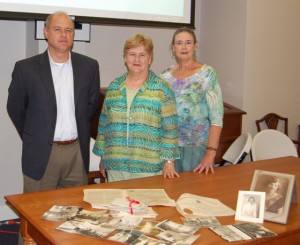
A collection of historical material from Parchman prison was recently donated to the University of Mississippi's Department of Archives and Special Collections by (from left) Bryan King, Catherine King and Kate Stewart.
OXFORD, Miss. – It was more than 80 years ago when Martha Alice Stewart walked into the Mississippi State Penitentiary, known as Parchman Farm, to assume her role as the head nurse. She was one of few to get an inside glimpse between the walls that make up the most notorious penitentiary in the South.
The public can share in her experience by visiting Archives and Special Collections at the University of Mississippi, where a new collection donated by Stewart’s family is housed. The “Martha Alice Stewart: Time on Parchman Farm, 1930s Collection,” is comprised of photos and other materials related to the penitentiary.“This collection will fill in a gap we have about the history of Parchman Farm,” said Pamela Williamson, curator of visual collections and assistant professor. “The images in the collection will benefit researchers by providing visual insight into the state’s self-sustaining penitentiary. They capture a piece of Mississippi history that has not previously been seen.”
“Time on Parchman Farm, 1930s,” an exhibit showcasing selected items from the collection, will run through Dec. 19 at the University of Mississippi Museum.
While working at Parchman for nearly a decade, Stewart accumulated a collection of nearly 200 black-and-white photos portraying life inside the prison, as well as nursing documents, personal cards and even a letter from a former inmate.
Stewart’s two nieces, Kate Stewart and Catherine King, and great-nephew, Bryan King, recently donated the collection to Ole Miss so that this important piece of Mississippi history would be forever preserved and available for public viewing. Kate Stewart and Bryan King are both Ole Miss alumni.
“The pictures and letters have been in an album upstairs in the old family home for years,” said Kate Stewart, a professor of English at the University of Arkansas at Monticello. “It is a rare look into the 1930s and an aspect of history that people normally do not think about so we wanted to share it with others.”
The prison, which is the oldest in Mississippi, was established in 1901 and has been housing prisoners for more than 100 years. It serves as a self-sufficient farm in which prisoners are used as labor to maintain the grounds.
The process of piecing this collection together has been ongoing for nearly four years.
For more information contact Pamela Williamson, curator of visual collections and assistant professor, at pmw@olemiss.edu or 662-915-5851.